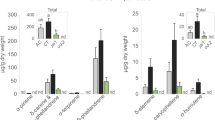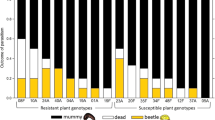Abstract
In many plants, defence systems against herbivores are induced through the octadecanoid pathway1,2, which may also be involved in recruiting natural enemies of herbivores3. This pathway can beinduced by treating plants with jasmonic acid4 or by natural herbivory, and increases resistance against herbivorous insects intomato plants5, in part by causing production of toxic and antinutritive proteinase inhibitors and oxidative enzymes6,7,8. Herbivore-infested tomato plants release increased amounts of volatiles9 and attract natural enemies of the herbivores10, as do other plants11,12,13,14,15. The octadecanoid pathway may regulate production of these volatiles, which attract host-seeking parasitic wasps16,17. However, plant resistance compounds can adversely affect parasitoids as well as herbivores18. It is unclear whether the combination of increased retention and/or attractiveness of parasitic wasps to induced plants and the adverse effects of plant defence compounds on both caterpillars and parasitoids results in a net increase in parasitization of herbivores feeding on induced plants.Here I show that inducing plants with jasmonic acid increases parasitism of caterpillar pests in an agricultural field twofold. Thus, elicitors of plant resistance may become useful in agriculture.
This is a preview of subscription content, access via your institution
Access options
Subscribe to this journal
Receive 51 print issues and online access
$199.00 per year
only $3.90 per issue
Buy this article
- Purchase on Springer Link
- Instant access to full article PDF
Prices may be subject to local taxes which are calculated during checkout


Similar content being viewed by others
References
Karban, R. & Baldwin, I. T. Induced Responses to Herbivory(Univ. of Chicago Press, Chicago, Illinois, 1997).
Meyer, A., Miersch, O., Buttner, C., Dathe, W. & Sembdner, G. Occurrence of the plant growth regulator jasmonic acid in plants. J. Plant Growth Regul. 3, 1–8 (1984).
Farmer, E. E. New fatty acid based signals: a lesson from the plant world. Science 276, 912–913 (1997).
McConn, M., Creelman, R. A., Bell, E., Mullet, J. E. & Browse, J. Jasmonate is essential for insect defense in Arabidopsis . Proc. Natl Acad. Sci. USA 93, 5473–5477 (1997).
Thaler, J. S., Stout, M. J., Karban, R. & Duffey, S. S. Exogenous jasmonates simulate insect wounding intomato plants, Lycopersicon esculentum, in the laboratory and field. J. Chem. Ecol. 22, 1767–1781 (1996).
Broadway, R. M., Duffey, S. S., Pearce, G. & Ryan, C. A. Plant proteinase inhibitors: a defense against herbivorous insects? Entomol. Exp. Appl. 41, 33–38 (1986).
Felton, G. W., Donato, K., del Vecchio, R. J. & Duffey, S. S. Activation of plant foliar oxidases by feeding reduces nutritive quality of foliage for noctuid herbivores. J. Chem. Ecol. 15, 2667–2694 (1989).
Orozco-Cardenas, M., McGurl, B. & Ryan, C. A. Expression of an antisense prosystemin gene in tomato plants reduces resistance toward Manduca sexta larvae. Proc. Natl Acad. Sci. USA 90, 8273 8276 (1993).
Dicke, M., Takabayashi, J., Posthumus, M. A., Schutte, C. & Krips, O. E. Plant-phytoseiid interactions mediated by herbivore-induced plant volatiles: variation in production of cues and in responses of predatory mites. Exp. Appl. Acarol. 22, 311–333 (1998).
Dicke, M. & Sabelis, M. W. How plants obtain predatory mites as bodyguards. Netherlands J. Zool. 38, 148–165 (1988).
Turlings, T. C. J., McCall, P. J., Alborn, H. T. & Tumlinson, J. H. An elicitor in caterpillar oral secretions that induces corn seedlings to emit chemical signals attractive to parasitic wasps. J. Chem. Ecol. 19, 411–425 (1993).
Hopke, J., Donath, J., Blechert, S. & Boland, W. Herbivore-induced volatiles: the emission of acyclic homoterpenes from leaves of Phaseolus lunatus and Zea mays can be triggered by a β-glucosidase and jasmonic acid. FEBS Lett. 352, 146–150 (1994).
Drukker, B., Scutareanu, P. & Sabelis, M. W. Do anthocorid predators respond to synomones from Psylla -infested pear trees under field conditions? Entomol. Exp. Appl. 77, 193–203 (1995).
Shimoda, T., Takabayashi, J., Ashihara, W. & Takafuji, A. Response of predatory insect Scolothrips takahashii toward herbivore-induced plant volatiles under laboratory and field conditions. J. Chem. Ecol. 23, 2033–2048 (1997).
De Moraes, C. M., Lewis, W. J., Paré, P. W., Alborn, H. T. & Tumlinson, J. H. Herbivore-infested plants selectively attract parasitoids. Nature 393, 570–572 (1998).
Boland, W., Hopke, J., Donath, J., Nuske, J. & Bublitz, F. Jasmonic acid and coronatin induce odor production in plants. Angew. Chem. Int. Ed. Engl. 34, 1600–1602 (1995).
Alborn, H. T. et al. . An elicitor of plant volatiles from beet armyworm oral secretion. Science 276, 945–949 (1997).
Campbell, B. C. & Duffey, S. S. Tomatine and parasitic wasps: Potential incompatibility of plant-antibiosis with biological control. Science 205, 700–702 (1979).
Strand, L. L. Integrated Pest Management for Tomatoes(Division of Agriculture and Natural Resources Communication Services—Publications, Oakland, 1998).
Takabayashi, J. & Dicke, M. Plant-carnivore mutualism through herbivore-induced carnivore attractants. Trends Plant Sci. 1, 109–113 (1996).
Clancy, K. M. & Price, P. W. Rapid herbivore growth enhances enemy attack: sublethal plant defenses remain a paradox. Ecology 68, 733–737 (1987).
Benrey, B. & Denno, R. F. The slow-growth–high-mortality hypotheses: a test using the cabbage butterfly. Ecology 78, 987–999 (1997).
Stout, M. J., Workman, K. V. & Duffey, S. S. Identity, spatial distribution, and variability of induced chemical responses in tomato plants. Entomol. Exp. Appl. 79, 255–271 (1996).
Bell, E. & Mullet, J. E. Characterization of an Arabidopsis lipoxygenase gene responsive to methyl jasmonate and wounding. Plant. Physiol. 103, 1133–1137 (1993).
Siedow, J. N. Plant lipoxygenase: structure and function. Annu. Rev. Plant Physiol. Plant Mol. Biol. 42, 145–188 (1991).
Paré, P. W., Alborn, H. T. & Tumlinson, J. H. Concerted biosynthesis of an insect elicitor of plant volatiles. Proc. Natl Acad. Sci. USA 95, 13971–13975 (1998).
Dicke, M., Sabelis, M. W., Takabayashi, J., Bruin, J. & Posthumus, M. A. Plant strategies of manipulating predator-prey interactions through allelochemicals: prospects for application to pest control. J. Chem. Ecol. 16, 3091–3118 (1990).
Acknowledgements
I thank C. Wardlaw and C. Black for help in the field; M. Stout and C. De Moraes for discussion; and A. Agrawal, R. Karban, M. Dicke, J. Rosenheim, L. Adler, C. Black, R. Kimura and J.Granett for comments on the manuscript. This research was supported by the USDA-NRI.
Author information
Authors and Affiliations
Corresponding author
Rights and permissions
About this article
Cite this article
Thaler, J. Jasmonate-inducible plant defences cause increased parasitism of herbivores. Nature 399, 686–688 (1999). https://doi.org/10.1038/21420
Received:
Accepted:
Issue Date:
DOI: https://doi.org/10.1038/21420
This article is cited by
-
Beyond 'push–pull': unraveling the ecological pleiotropy of plant volatile organic compounds for sustainable crop pest management
Crop Health (2023)
-
Nitrogen-Fixing Rhizobia Affect Multitrophic Interactions in the Field
Journal of Insect Behavior (2023)
-
Generalist herbivore response to volatile chemical induction varies along a gradient in soil salinization
Scientific Reports (2022)
-
Effects of elevated CO2 on resistant and susceptible rice cultivar and its primary host, brown planthopper (BPH), Nilaparvata lugens (Stål)
Scientific Reports (2021)
-
Identifying aphid resistance in the ancestral wheat Triticum monococcum under field conditions
Scientific Reports (2021)
Comments
By submitting a comment you agree to abide by our Terms and Community Guidelines. If you find something abusive or that does not comply with our terms or guidelines please flag it as inappropriate.



